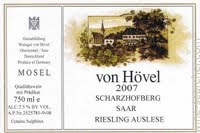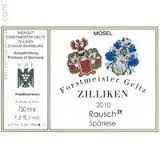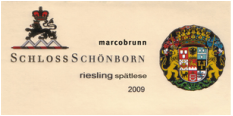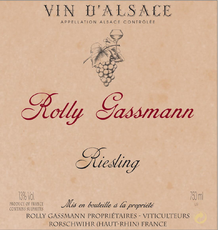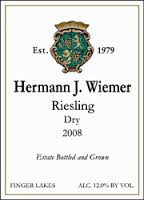|
|
|
I'm Michael Amendola, a lifelong food and wine lover, a professional musician, and a wine professional who has worked in the industry for the past 14 years. I'm currently the Wine Director for The Village Wine Merchant in Sea Cliff, NY where I'm able to taste many, many wines and where I regularly conduct classes and tastings for customers. I've also worked in several wine shops and written about wine for many blogs and publications. I believe that wine is culture, a way of life, and in my columns I'll be sharing my passion and knowledge in a direct and unpretentious way. |
Riesling - The Most Misunderstood
Understanding Riesling
Riesling is one of the most loved and respected grape varieties by connoisseurs and wine professionals, yet many wine drinkers say that they don't like it. What's the disconnect? The pros love it because Riesling can produce wines of great complexity and because of something called transparency. This is the ability of the wine to translate the specifics of it's vineyard site into flavors, aromas, and textures that present themselves in the glass. Riesling is excellent at this and the result is that within the grape's flavor profile, you get an infinite variety of expression. People that drink a lot of wine appreciate this because it's interesting and keeps things from becoming predictable and boring. Why do the occasional wine drinkers say they don't like Riesling? Well, the elephant in the room is the phrase "sweet wines" and that's viewed as part of Riesling's persona. Many people associate wines they perceive as being sweet as being of inferior quality, which is just inaccurate and misinformed. Additionally, I find that a lot of casual wine drinkers don't truly understand the differences between a wine that's fruity, yet dry, and actual sweetness. I'm not going to elaborate on a discussion of sweet and dry (that's for another post) but I will say that this belief by some that they "don't like sweet" precludes them from giving delicious Rieslings a chance. Part of the joy of drinking Riesling is that the grape can create a dialogue and tension between ripeness, fruitiness, and acidity all while delivering complexity in a range of successful styles. Regions and Labels The historically famous regions for Riesling are in Germany, Austria, and Alsace in France. While languages and labels can be confusing, almost all of the wines from Austria and Alsace are dry, the exception being late harvest wines which will be designated as such, for example "Vendange Tardive" in French. Germany is a little more complicated as certain wines, considered of superior quality and labeled as "QmP", carry designations. You may see the words Kabinett, Spätlese, Auslese, Beerenauslese, Trockenbeerenauslese, or Eiswein on the label. These are ripeness designations and can give a clue to the body and richness of the wine. Generally, dry wines come mostly from bottles labeled Kabinett (the lighter wines), occasionally from Spätlese (a later picking), and rarely Auslese. If the word "Trocken" appears on the label then the wine is fermented dry, "Halbtrocken" and "Feinherb" would indicate that the wine is less dry, half-dry, or off-dry. These varying levels of sugar are necessary to balance Riesling's racy acidity. You can actually have a wine designated "Feinherb" which has more residual sugar yet feels drier on the palate than a "Kabinett Trocken" if the acidity level is higher. A good general indicator for the style, outside of the dessert wines, is the alcohol level. Wines under 10% alcohol will feel fruity and sweet, between 10%-12% will be a bit drier, and over 12% the finish will be bone dry. Other areas that produce quality Riesling in Europe are northern Italy, and some eastern and central European countries like Slovenia, Hungary, and Moravia in the Czech Republic. Excellent wines are also made in the US, the Finger Lakes in New York State is a leader along with some surprises from Long Island, Michigan, and Washington State. In addition, while not currently in fashion, the Hunter Valley in Australia has a long history with the grape. In order determine style in the new world wines simply look for the words "Dry" or "Semi-Dry" on the label. The Dessert Wines These are the truly sweet wines, unctuous, ripe and full-bodied. Again it's Riesling's high natural acidity that keeps things in balance, allowing the sugars to build without the wine becoming cloying. To find a dessert wine look for "Late Harvest" on the label, or the German words Auslese, Beerenauslese (BA), Trockenbeerenauslese (TBA) or the special Eiswein made from grapes that have frozen on the vine and concentrated the sugars. When Tasting So get into Riesling! When tasting pay particular attention to the interplay between the fruit and the crisp acidity, see when one or the other backs off or takes over the conversation. This grape has some unique flavor elements, look for them. Lime skin, citrus pith, flower oils, and petrol are common descriptors. As I mentioned Riesling is prized for it's transparency, if you taste one from a great vineyard site see if you get a unique impression of minerality. It's one of the more difficult sensations to describe but if it's there you'll know it. Michael What to Drink:
Von Hövel - Scharzhofberger Riesling Kabinett 2013 - Saar (Germany) Schloss Schönborn - Spätlese Erbacher Marcobrunn 2004 - Rheingau (Germany) Zilliken - Kabinett Saarburger Rausch 2014 - Mosel (Germany) Hans Wirsching - Iphofer Riesling QbA Trocken 2014 (bocksbeutel) - Franconia (Germany) Rolly Gassmann - Alsace Riesling (2012) - Alsace (France) Hermann J. Wiemer - Dry Riesling 2014 - Finger Lakes (USA) |

